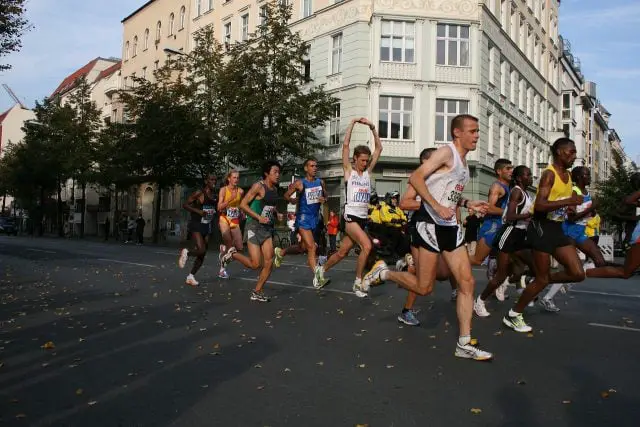Whether you wish to run a marathon to make new friends, raise funds for a charity or simply to prove yourself to someone or yourself is an entirely private matter, the ‘how’ you do it and ‘how’ you prepare for it requires dedication.
Depending on your level of fitness and familiarity with the sport, you can opt for a half or full marathon program, which in turn, covers all levels of preparation from the beginners’ level to intermediate and advanced. For those of you who have not taken part in a marathon before but are considering it from now on, Hal Higdon has developed the perfect half marathon training schedule we will brief you about shortly.
Half Marathon Training Plan
Training for a half marathon entails possessing a certain anabolic capacity, however, starting from the assumption that no major health problems hinder your ability to train, this schedule takes into consideration that a healthy individual can train to complete a 13.1-mile race.
Half Marathon Training for Beginners – Novice 1
If you’re a first timer, here’s what you need to focus on, according to Higdon.
Pace. Speed is not important here. Find a pace that you’re comfortable with and keep it up. If you wear a heart rate monitor, you should aim to reach a speed between 65 and 75 percent of your maximum pulse rate.
Distance. The Hal Higdon half marathon training for beginners recommends training at distances that range from 3 to 10 miles. You need not worry about going exactly by the book, so long as you come close to that distance it’s fine.
Pick up a route around your neighborhood and consider wearing a GPS watch to help you measure your course. Talking to other runners may also help you decide where to train.
Rest intervals. Resting is an essential part of your half marathon training regimen. If you rest whenever you feel you need to will help you run long distances.

Long-distance running. Running long distances is at the core of half marathon training, incrementally adding a few miles with each of your runs. Spread over a 12-week period, your distance will gradually increase from 3 to 10 miles. Ultimately, following a brief slowdown, it will hit 13.1 miles. Table 1 below shows exactly that.
Cross-training. Referred to as “cross” in the table below, cross-training allows you to recover after the hardcore runs during the week. Aerobic exercises tend to work best, Higdon says. Alternatively, you can choose from cycling, walking, skiing, or even strength training combos.
Active breaks. Although it’s a very good exercise, walking is somewhat overlooked by training runners. Taking a walking break in-between your runs whenever you feel tired is the ideal way to rest.
Strength training. If you are not an experienced weightlifter, now is not exactly the ideal time to start, Higdon suggests. However, if normally lift weights it is a good reason to continue your favorite workout as part of your half marathon training protocol. Fit that into your training schedule after running days.
Race drill. To get the big picture, consider running a good 5-mile race distance at the end of the 6th week and a 10-mile race distance after week 9. Feel free to adjust the distance as you feel comfortable with and not exhaust yourself.
Alternate workouts. Swap workouts each day and each week. What matters is consistency, as long as you train consistently, the details are less important.
Hal Higdon Half Marathon Training Schedule – Novice 1
| WEEK | MON | TUE | WED | THU | FRI | SAT | SUN |
|---|---|---|---|---|---|---|---|
| 1 | Rest | 3 m run | 2 m run or cross | 3 m run | Rest | 30 min cross | 4 m run |
| 2 | Rest | 3 m run | 2 m run or cross | 3 m run | Rest | 30 min cross | 4 m run |
| 3 | Rest | 3.5 m run | 2 m run or cross | 3.5 m run | Rest | 40 min cross | 5 m run |
| 4 | Rest | 3.5 m run | 2 m run or cross | 3.5 m run | Rest | 40 min cross | 5 m run |
| 5 | Rest | 4 m run | 2 m run or cross | 4 m run | Rest | 40 min cross | 6 m run |
| 6 | Rest | 4 m run | 2 m run or cross | 4 m run | Rest or easy run | Rest | 5-K Race |
| 7 | Rest | 4.5 m run | 3 m run or cross | 4.5 m run | Rest | 50 min cross | 7 m run |
| 8 | Rest | 4.5 m run | 3 m run or cross | 4.5 m run | Rest | 50 min cross | 8 m run |
| 9 | Rest | 5 m run | 3 m run or cross | 5 m run | Rest or easy run | Rest | 10-K Race |
| 10 | Rest | 5 m run | 3 m run or cross | 5 m run | Rest | 60 min cross | 9 m run |
| 11 | Rest | 5 m run | 3 m run or cross | 5 m run | Rest | 60 min cross | 10 m run |
| 12 | Rest | 4 m run | 3 m run or cross | 2 m run | Rest | Rest | Half Marathon |
Half Marathon Training Schedule – Novice 2
While the Novice 1 program targets marathon newbies, Novice 2 addresses a little bit more experienced runners.
Long-distance running. Long runs are at the core of this 12-week half marathon training protocol. Start from 4 miles in week 1 and gradually increase up to 12 miles in week 11. A week of slow pace training and recovery follows so you reach D day well rested. While you can skip a few cross-training workouts, sticking to your runs is crucially important, Higdon says.
Slow running. Speed is not important here. Even for experienced runners, Higdon recommends reducing speed for long-distance runs to anywhere between 30 to 90 seconds or more per mile slower than their actual half marathon speed. Find a comfortable rhythm and stick to it. What is important here is covering the prescribed distance.
Active breaks. While other trainers recommend taking walking breaks when reaching certain pre-defined points, Higdon suggests walking whenever you reach an aid station. Walking you can avoid collision with someone and you can drink a lot easier. It is therefore advisable that you also include walking in your regular marathon training routine.
Cross-training. The last day of the week is dedicated to cross-training in this program. On this day your muscles can actively relax while cycling, doing aeorobic exercise or walking. Don’t exhaust yourself; this should be a light workout for about 60 minutes. You don’t have to repeat the same kind of cross-training, feel free to improvise or even combine two or more types of exercises.

Midweek prep. Even during the week, Higdon says, training should be done at a comfortable pace, gradually increasing the rhythm as the weekend approaches, which generally is more marathon-like (Saturdays). What is important at this stage is listening to your body as well as those of the GPS watch. Take a break when you’re tired. Wednesdays build up from 3 to 5 miles combining running with cross-training workouts. If you are a weightlifter, combine weightlifting with running, in which case it’s best that you do your running before weightlifting on Tuesdays and Thursdays, as per Higdon’s schedule outlined in the table below.
Pace. In this context, “pace” refers to the race pace (the rhythm you’re planning to run in the race you train for). For example, if you’re training for a 2:00 half marathon, your training pace per mile should be 9:09.
Race drill. Include a 5-mile race drill running into your training program during week 6 and a 10-mile race during week 9. Doing this will give you an exact idea of how well prepared you are for the race day and determine your fitness level.
Rest intervals. Scientists recommend rest intervals of 24 to 72 hours between hardcore sessions of exercise. That will help your muscles recover and build strength.
Hal Higdon Half Marathon Training Schedule – Novice 2
| WEEK | MON | TUE | WED | THU | FRI | SAT | SUN |
|---|---|---|---|---|---|---|---|
| 1 | Rest | 3 m run | 3 m run | 3 m run | Rest | 4 m run | 60 min cross |
| 2 | Rest | 3 m run | 3 m pace | 3 m run | Rest | 5 m run | 60 min cross |
| 3 | Rest | 3 m run | 4 m run | 3 m run | Rest | 6 m run | 60 min cross |
| 4 | Rest | 3 m run | 4 m pace | 3 m run | Rest | 7 m run | 60 min cross |
| 5 | Rest | 3 m run | 4 m run | 3 m run | Rest | 8 m run | 60 min cross |
| 6 | Rest | 3 m run | 4 m pace | 3 m run | Rest | 5-K Race | 60 min cross |
| 7 | Rest | 3 m run | 5 m run | 3 m run | Rest | 9 m run | 60 min cross |
| 8 | Rest | 3 m run | 5 m pace | 3 m run | Rest | 10 m run | 60 min cross |
| 9 | Rest | 3 m run | 5 m run | 3 m run | Rest | 10-K Race | 60 min cross |
| 10 | Rest | 3 m run | 5 m pace | 3 m run | Rest | 11 m run | 60 min cross |
| 11 | Rest | 3 m run | 5 m run | 3 m run | Rest | 12 m run | 60 min cross |
| 12 | Rest | 3 m run | 2 m pace | 2 m run | Rest | Rest | Half Marathon |
Half Marathon Training Schedule Intermediate 1
Long-distance running. At the core of this program are long-distance runs, gradually building up from 4 miles in week 1 to 12 miles thru week 11. After that, you slow down for a week to be well rested for the marathon. While the table below schedules long runs on Sundays, feel free to adjust that as it suits your agenda. What is crucially important is not to skip those from your training.
Slow running. Even if you are an experienced runner, don’t exceed 90 or more seconds per mile. Keep it anywhere in-between 30 and 90s/mile. Find a pace you feel comfortable with and focus on the distance.
Active breaks. Walking in-between runs allows your muscles to recover slowly and it’s widely recommended for you to follow this strategy while training (see above recommendations).

Cross training: In this program, Mondays are cross-training days, gradually increasing training duration from 30 to 60 minutes. You can choose from swimming, cycling, walking or easy jogging.
Midweek prep. As you add a few miles to your weekend long runs, Tuesdays and Thursdays mileage also grows from 3 to 5 miles and jump from 4 to 8 miles on Wednesdays. Run at a comfortable pace, focus on the distance not the speed. If you strength train, recommendations are the same as for previous level midweek prep. Pace. See Novice 2 above pace recommendations.
Race drill. Include a marathon-like 5-mile run into your training during week 6 and a 10-mile run during week 10.
Rest intervals. 24 to 72 hours in-between hardcore training bouts.
Half Marathon Training Intermediate 1
| WEEK | MON | TUE | WED | THU | FRI | SAT | SUN |
|---|---|---|---|---|---|---|---|
| 1 | 30 min cross | 3 m run | 4 m run | 3 m run | Rest | 3 m run | 4 m run |
| 2 | 30 min cross | 3 m run | 4 m pace | 3 m run | Rest | 3 m pace | 5 m run |
| 3 | 40 min cross | 3.5 m run | 5 m run | 3.5 m run | Rest | Rest | 6 m run |
| 4 | 40 min cross | 3.5 m run | 5 m pace | 3.5 m run | Rest | 3 m run | 7 m run |
| 5 | 40 min cross | 4 m run | 6 m run | 4 m run | Rest | 3 m pace | 8 m run |
| 6 | 50 min cross | 4 m run | 6 m pace | 4 m run | Rest or easy run | Rest | 5-K Race |
| 7 | Rest | 4.5 m run | 7 m run | 4.5 m run | Rest | 4 m pace | 9 m run |
| 8 | 50 min cross | 4.5 m run | 7 m pace | 4.5 m run | Rest | 5 m pace | 10 m run |
| 9 | 60 min cross | 5 m run | 8 m run | 5 m run | Rest or easy run | Rest | 10-K Race |
| 10 | Rest | 5 m run | 8 m pace | 5 m run | Rest | 5 m pace | 11 m run |
| 11 | 60 min cross | 5 m run | 6 m run | 4 m run | Rest | 3 m pace | 12 m run |
| 12 | Rest | 4 m run | 4 m pace | 2 m run | Rest | Rest | Half Marathon |
Half Marathon Training Schedule Intermediate 2
Compared to Intermediate 1, this program focuses more on speed, while the previous one works more on building endurance.
Slow runs. Run at a speed anywhere in-between 65 and 75 percent of your maximum pulse rate. Tuesdays, Thursdays and/or Saturdays are slow running days.
Distance. While the training schedule recommends workout distances that range from 3 to 12 miles, don’t worry about not covering the exact distance from day 1 of your training so long as you come anywhere close. Choose a route you like and hit the pavement.
Stretch & Strength. Include some stretching and strength exercises into your daily workout regimen, especially after you finish your run. It’s also crucially important to stretch during your warm-up for the hardcore running on Wednesdays (see Table 4 below).
Strength training could include push-ups, free weight lifting or working out with various machines. For best results, combine light weight lifting with a series of reps rather than pumping heavy iron.
Rest intervals. Take one or more days off to recover post really heavy training bouts if you need to. Be realistic and don’t exhaust yourself!
Long-distance running. The gist is gradually increasing mileage each weekend to get ready to finish the long marathon race. Your longest run will build up from 5 to 12 miles over an 11-week period, reaching 13.1 miles in the final week and the race itself.
Active breaks. Walking is an excellent way to actively recover from heavy workouts. Stop running and star walking whenever you feel tired.
Race drill. This program covers 3 race warm-up drills, a 5 mile, 10 mile and 15 mile races, distributed evenly every third week.

Speed. This Hal Higdon half marathon training schedule for intermediate 2 runners recommends alternating interval running with tempo runs. Interval training comprises of a set of quick reps separated by moving breaks such as slow jogging or walking. The program starts with 5 x 400 m runs in the first week adding one more 400 m every other week till it reaches 10 x 400 m the week before the competition.
Tempo runs. This kind of training involves continuous running with a pace and speed buildup close to a 10-mile race. According to Higdon, a tempo run of 30 – 45 minutes commences with 10-15 minutes of slow running, builds up to 15-20 minutes towards the middle and ends with 5-10 minutes of slow running. Speed builds up gradually, reaching a peak at about two-thirds into the workout. Maintain that peak for 1-2 minutes. Improvise!
Pace. Run at and maintain the pace you aim to run at during the race. Some workouts have been developed as pace runs to help you get into the racing rhythm. Week 10, for instance, requires you to complete a 5m race pace. A short warm-up beforehand is required.
Warm-up. Warming up is key before each running workout and pace runs as well as before the race. You can consider jogging a mile or two followed by 5-10 minutes’ stretching and a good 100 m easy running before you start speeding.
Cross-training. Mondays are recommended for this kind of active recovery. Do some aerobic exercise like walking, cycling, snowshoeing or an exercise combo including strength training. The gist here is not to push yourself too much.
Alternate workouts. For maximum benefit, juggle workouts as you feel like on a daily and weekly basis. What matters is consistency. If you take an extra day off when you’re tired does not matter so much as long as you still train and do it properly.
Hal Higdon Half Marathon Training Intermediate 2
| WEEK | MON | TUE | WED | THU | FRI | SAT | SUN |
|---|---|---|---|---|---|---|---|
| 1 | 30 min cross | 3 m run | 5 x 400 5-K pace | 3 m run | Rest | 3 m run | 5 m run |
| 2 | 30 min cross | 3 m run | 30 min tempo | 3 m run | Rest | 3 m pace | 6 m run |
| 3 | 40 min cross | 3.5 m run | 6 x 400 5-K pace | 3 m run | Rest | Rest | 5-K Race |
| 4 | 40 min cross | 3.5 m run | 35 min tempo | 3 m run | Rest | 3 m run | 7 m run |
| 5 | 40 min cross | 4 m run | 7 x 400 5-K pace | 3 m run | Rest | 3 m pace | 8 m run |
| 6 | 50 min cross | 4 m run | 40 min tempo | 3 m run | Rest or easy run | Rest | 10-K Race |
| 7 | Rest | 4.5 m run | 8 x 400 5-K pace | 3 m run | Rest | 4 m pace | 9 m run |
| 8 | 50 min cross | 4.5 m run | 40 min tempo | 3 m run | Rest | 5 m pace | 10 m run |
| 9 | 60 min cross | 5 m run | 9 x 400 5-K pace | 3 m run | Rest or easy run | Rest | 15-K Race |
| 10 | Rest | 5 m run | 45 min tempo | 3 m run | Rest | 5 m pace | 11 m run |
| 11 | 60 min cross | 5 m run | 10 x 400 5-K pace | 3 m run | Rest | 3 m pace | 12 m run |
| 12 | Rest | 4 m run | 30 min tempo | 2 m run | Rest | Rest | Half Marathon |
Half Marathon Training Schedule Advanced
This program suits experienced runners looking to improve their performance. Most often, those who choose to follow this protocol already have the experience of half and full marathon races.
Slow runs. Mondays, Wednesdays, and Fridays or Saturdays are usually dedicated to slow running in this Hal Higdon program. Run at a pace you’re comfortable with. If you’re wearing a heart rate monitor, it will be easier for you to pinpoint the ideal pace somewhere between 65 and 75 percent of your maximum pulse rate.
Stretch & Strength. Mondays and Wednesdays are also dedicated to strength training and stretching. While it’s advisable to stretch and strength train pretty much every day post running, these days should mainly focus on this kind of workouts in an “easy” way. Do some pull-ups, push-ups and light weight lifting or hit the treadmill at low speed.
Distance. While the book recommends running distances from 3 miles to 2 hours, run at your own pace and without being so mindful about the distance so long as you get anywhere close to that figure. Choose a route that you enjoy running and start trotting!
Rest intervals. Listen to your body and take as long and frequent breaks as you need, especially in the terminal weeks of your training. Resting is the only way to avoid injuries.
Hills. Yes, this program takes it up a notch with hill running (3 sessions). The recommended height is anywhere between 200 and 400 m. Jog or walk an equal distance in-between reps. You may even substitute hill runs for tempo runs or any interval workouts.
Speed. The advanced half marathon training schedule starts with 400 m reps, gradually increasing to 800 and 1600 m. Walk or jog in-between reps.
Warm-up. While novice runners don’t need to warm up before the race so much, as they’re aiming to finish the marathon rather than finish it fast, as and advanced runner, your goal is different, so warm up is key. You can jog a mile or two, stretch for 5-10 minutes and run about 100 at race pace. Cool down by doing half the warm-up distance.

Tempo runs. Follow the same instructions as above. The difference with the advanced program is that tempo runs last between 40 and 60 minutes, and begin with 10-20 minutes of slow running, build up to 20-30 minutes towards the middle, and end with 10-20 minutes of slow running. Again, improvisation is at the heart of this kind of training.
Pace. Race pace. Same as above. Warm up before pace runs.
Long-distance running. While you probably run 60-90 minutes anyway every weekend as an advanced runner, with this program you will need to take it up a notch and increase time to 1:45 – 2 hours, especially as you approach race day. Run at a pace you’re comfortable with except those days when you are required to run 3/1 and don’t stress about finishing fast. A 3/1 run starts with slow running and requires you to speed up to race pace after covering three fourths of the distance. At the end of your run you should feel refreshed.
Cross-training. Same as above.
Alternate workouts. Same as above.
Race drill. With this program you will have the pleasure of enjoying a race-like run once every three weeks, starting from 5-mile, 10-mile up to 15-mile race running. Same recommendations as above.
Hal Higdon Half Marathon Training Advanced
| WEEK | MON | TUE | WED | THU | FRI | SAT | SUN |
|---|---|---|---|---|---|---|---|
| 3 m run | 6 x hill | 3 m run | 40 min tempo | Rest | 3 m run | 90 min run (3/1) | |
| 3 m run | 7 x 400 5-K pace | 3 m run | 45 min tempo | Rest | 3 m pace | 90 min run | |
| 3 m run | 7 x hill | 3 m run | 30 min tempo | Rest or easy run | Rest | 5-K Race | |
| 3 m run | 8 x 400 5-K pace | 3 m run | 40 min tempo | Rest | 3 m run | 90 min run (3/1) | |
| 3 m run | 8 x hill | 3 m run | 45 min tempo | Rest | 3 m pace | 90 min run | |
| 3 m run | 8 x 400 5-K pace | 3 m run | 30 min tempo | Rest or easy run | Rest | 10-K Race | |
| 3 m run | 4 x 800 10-K pace | 3 m run | 45 min tempo | Rest | 4 m pace | 1:45 run (3/1) | |
| 3 m run | 3 x 1600 race pace | 3 m run | 50 min tempo | Rest | 5 m pace | 1:45 run | |
| 3 m run | 5 x 800 10-K pace | 3 m run | 30 min tempo | Rest or easy run | Rest | 15-K Race | |
| 3 m run | 4 x 1600 race pace | 3 m run | 55 min tempo | Rest | 5 m pace | 2:00 run (3/1) | |
| 3 m run | 6 x 800 10-K pace | 3 m run | 60 min tempo | Rest | 3 m pace | 2:00 run | |
| 3 m run | 6 x 400 5-K pace | 2 m run | 30 min tempo | Rest | Rest | Half Marathon |
Training for a Half Marathon Diet
While training is at the core of your marathon preparation, nutrition is also important. According to Kathleen Porter, MS, registered dietitian and runner from New York City, a balanced half marathon training diet should consist of the following:

10-20% of calories from lean proteins (chicken, fish, meat, beans, nuts, etc.)
20-30% of calories from healthy fats (oils, avocado, nuts, fatty fish, etc.)
50-70% of calories from carbohydrates (fruits, vegetables, bread, rice, pasta, grains, etc.)
For optimum performance, personal trainer and dietitian Cindy Sherwin recommends having a snack within one hour (ideally 30 minutes post run) after finishing your training. This post-workout snack should be rich in carbs and protein but not exceed a ratio of 4/1, however.
Complex carbs such as whole wheat toast, rolled oats, or sweet potato with some delicious peanut butter spread to slow down digestion is always an excellent, mouth-watering choice. If you’re not so sweet toothed, then half a cup of yogurt and some fruit (blueberries or blackberries) will definitely refuel your system and give you an energy boost.
Useful tips:
- Add complex carbs to your diet. Complex carbs can be found in grains, rice, vegetables, bread, and fruit. Veggies such as beans, peas and lintels are great for races. Because they take longer to digest, they fuel energy into your system when need arises.
- Drink a lot of water, especially during long runs (every 30 minutes or as needed). Dehydration leads to sluggishness, and that’s exactly what you don’t need.
- Iron up! If you don’t consume enough iron from iron-rich foods or supplements, you risk becoming anemic, which leads to physical weakness and fatigue. To avoid iron depletion, eat more lean red meat and leafy greens such as spinach or kale.
- The night before the race, eat a nutritious meal consisting of either whole grains such as brown rice or whole wheat pasta, steamed or grilled veggies or a salad (romaine lettuce, carrots, tomatoes, cucumber, lettuce, yams, and a very light dressing), and a small amount of protein (chicken, eggs, fish or beef). Again, don’t experiment, stick to what you’re familiar with. For instance, if whole grains caused some trouble during training days, switch to their white counterparts.
- D Day breakfast: Cereal or oats mixed with yogurt or milk and half a bagel is a perfect choice. Have a cup of coffee if you like a bit of a boost from caffeine.

Conclusion
Now that you know all there is to know about marathon training, all you need to do is consult with your doctor and trainer to rule out any health risks and get ready for your first half marathon race.
Sources:
http://www.fitnessmagazine.com






